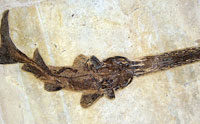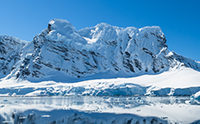Earth’s iron-nickel core has a solid inner layer and a liquid outer layer. A recent paper presents a huge dilemma for naturalistic explanations of Earth’s origin. Earth’s solid inner core shouldn’t exist!1 Secular scientists had long assumed the inner core was initially in a liquid state but that lower temperatures caused the liquid at the center to begin to solidify. Supposedly the solid… More… …read more Source: icr.org
Is there enough time for permafrost to form in the biblical timeframe? …read more Source: creation.com
The theory of plate tectonics recently turned fifty. Contrary to the claims of its critics, the theory of plate tectonics is derived from empirical data collected over many decades by geologists and geophysicists.1 In the early 20th century, Alfred Wegener studied the shapes of the continents, matched fossils and mountain ranges across vast oceans, and suggested that the continents had drifted apart. At the time… More… …read more Source: icr.org
Highly concentrated fossil tracks found near NASA Goddard Space Center support Noah’s Flood …read more Source: creation.com
The petrified tree-trunks found in the beautiful national park at Yellowstone have been used for years to ‘prove’ that the Earth cannot be young as the Bible indicates. But the evidence shows otherwise. …read more Source: creation.com
A recent article by a team of paleontologists, led by Hesham Sallam, of Mansoura University, Egypt, claims to have found the Holy Grail of dinosaurs in the middle of Egypt.1 The Genesis Flood model easily explains this unique discovery. The Genesis Flood model easily explains this unique discovery. More… …read more Source: icr.org
Evolution relies on deep time which in turn relies on naturalism but science tells us the earth is young and so evolution is false. …read more Source: creation.com
Where in the geologic record is the Flood/post-Flood boundary? …read more Source: creation.com
Why unexpected fossil finds won’t falsify evolution. …read more Source: creation.com
When a bomb exploded right next to Samiha at St. Peter’s Church in Cairo on December 11, 2016, everyone thought she was dead. But Samiha miraculously survived—and now testifies of Jesus’ presence throughout her recovery. Samiha Tawfiq Awad and her husband Qalini prepared to go to church on one Sunday morning in December 2016. Qalini said he was tired, but Samiha encouraged him not to miss church. Once at St. Peter’s, the two parted ways. Qalini went to sit in the men’s section, and Samiha took her seat in the women’s section—an early church tradition still practiced by [More]
The geology of south-west Western Australia interpreted from a biblical perspective. …read more Source: creation.com
Scientists believed marine stromatolites were extinct—until they found them living in Shark Bay, Australia, in 1956. Living stromatolites keep popping up in more diverse environments. The latest research identified them even living on land. More… …read more Source: icr.org
Two recent articles in Nature Geoscience may provide important validations of the global Flood. Did researchers find evidence of the “fountains of the great deep” that started the deluge? More… …read more Source: icr.org
Millions of wooly mammoths once lived around the world, particularly in extremely cold places. These elephantine creatures present a major mystery for secular scientists. Why is that? How could wooly mammoths survive the frigid climate of an ice age? And where would they find a sufficient food supply? Read More: The Mystery of Wooly Mammoths | The Institute for Creation Research
Geologists reassessed the abundance of fossils in Earth’s uppermost rock layers this year, and they believe they found a remarkable sixth global extinction event. Their discovery has two significant implications. More… …read more Source: icr.org
Some are concerned that global warming will cause the polar ice caps to melt, leading to an increase in global sea level. If such a rise in sea level occurred slowly, coastal peoples would have time to adjust to the change. But many are concerned that sea level could rise rapidly, leading to a humanitarian catastrophe. Although some scientists claim that satellite and tide-gauge data confirm a rapidly rising sea level, others are skeptical. In fact, two Australian scientists, Dr. Albert Parker and Dr. Clifford Ollier, have recently charged that Indian Ocean sea-level data for the last 140 years [More]
The Institute for Creation Research has monitored the steady flow of fresh-looking fossils for over a decade. The year 2017 was impressive with its discoveries of biochemical variety that includes proteins, pigments, and even a pineal gland. Each such discovery presents a real challenge to the millions-of-years age assignments for these fossils, since best-case scenarios predict that biochemicals fizzle out in less than one million years. Read More: Best of 2017: Fleshy Fossils | The Institute for Creation Research
Research provides evidence that nuclear transmutation rates were dramatically higher in the past. …read more Source: creation.com
Extraordinary claims about this extraordinary creature don’t always match what the science is revealing. …read more Source: creation.com
Twelve criteria to use to define where the Flood stops in the rock record. …read more Source: creation.com
A team of scientists claims to have found the “oldest polar forest on record from the southern polar region.” The trees were found in Antarctica’s Transantarctic Mountains and include a mix of evergreens, deciduous trees, and gingkoes. How old is this oldest polar forest? More… …read more Source: icr.org
How an icon of secular geology provides powerful evidence for Noah’s Flood. …read more Source: creation.com
Abstract The Sauk megasequence is thought to have been deposited during one of the highest sea level episodes of the Phanerozoic. However, few, if any, have examined the extent and volume of sediments deposited across entire continents in order to test the published, secular sea level curve against the rock record. This study examines the Lower Paleozoic sedimentary rocks across North America, South America, and Africa with particular attention given to the Sauk megasequence. Results show that the Sauk megasequence most likely represented a limited rise in global sea level. Africa and South America exhibit very little evidence of [More]
I saw a story in the news recently that reminded me of the tentative nature of historical science (the kind of science that is not directly testable, observable, and repeatable because it deals with the past) and how frequently the evolutionary story changes. Many fossil bones have been discovered covered in cuts and scrapes. Researchers thought this demonstrated that our supposed human ancestors (really just ape species) used tools to get the meat off. But a new study says the marks on the bones may have been made by crocodiles instead! Read More: Did Hominids or Crocodiles Make Marks [More]
By Raymond Strom Size and roundness statistics were generated for 17 samples. The quartz and K-feldspar showed statistically significant rounding from the beach to the dune. …read more Source: AIG Daily
Geological forces could cause a devastating landslide. …read more Source: creation.com
A sack with petrified contents shows that millions of years is not needed for the process to take place. …read more Source: creation.com








































